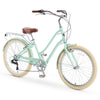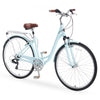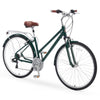Bike Lanes & Sharrows 101
Copy Link
http://www.sixthreezero.com/blogs/bike-advice/bike-lanes-sharrows-101

If you’ve found yourself wondering where in the street you should ride, you’re not alone. From beginning cyclists to riding pros, we all come across what can seem like a confusing mess of lines, stripes or lack thereof. Where is it safe to ride? Where can you ride or not ride at all? We’ll break down cycling safety for you so you can enjoy riding and hopefully not have to deal with cycling injuries.
Some of the markings you’ll come across as you ride streets and highways include arrows with a picture of a bicyclist, striped lanes with a picture of a bicyclist in the center, green paint, white paint and even physical poles indicating an area for you to stay in. These markings are meant to make conditions safer for riders, keeping cars away from you and you out of the road.
Markings may designate bikers-only lanes, shared areas of a road or highway and sections of streets that you should not be in. Here are some of the more common markings you’ll find as you ride:
Striped Bike Lanes
Striped bikes lanes are created to give cyclists a better sense of where they should be on the road. These lanes are usually striped white, and they’re typically located to the far right of the road. Sometimes, they’re painted a different color to make them more prominent. Vehicle drivers may not drive or park in a striped bike lane.
Buffered Bike Lanes
Buffered bike lanes provide cyclists with the added benefit of a dedicated riding lane, which means there is more space between a cyclist and a passing car. These lanes are painted and they give the rider a safety zone of 1 to 2 feet. Vehicle drivers have to stay to the left of the buffer zone, and they can only cross this bike lane when turning or entering a property on the other side of the lane (when cyclists are not in that part of the lane).
Protected Bike Lanes
You may not see protected bike lanes everywhere because they can cost more to construct than other bike lanes. These lanes, however, feature physical barriers like poles or other structures that keep cyclists in their own lane and cars out. Protected bike lanes clearly indicate to vehicle drivers that their cars are not permitted in the lane. Sometimes, concrete barriers or planters zone off a protected bike lane.
Sharrows
You’ll know when you see sharrows pavement markings if you learn to identify the arrows accompanied by a picture of a cyclists. Combining the words “share” and “arrows,” sharrows are meant to be visual reminders for vehicle drivers and cyclists that the road must be shared. Sharrows don’t give riders a designated space to ride. They highlight to all that the section of street or highway is generally a good place for a cyclists, but that all must use caution.
As a new or experienced rider, it’s important to always be aware of bike safety tips and riding rules that can keep you safe while on public roads. Now that you know where you can ride, where will you go? Check out Sixthreezero’s bikes for sale online, and then pick one and choose your journey.
Join our Journey Club to uncover new and exciting ride locations around the globe!
Take our Free Body Fit Questionnaire
Similar Articles
If you fall outside the average measurements of most folks, you know that sizing items are...
Getting started when biking uphill, it's going to be hard when you start off, especially if...
Now that spring is here, it's sunny, you definitely want to get that vitamin D and...















